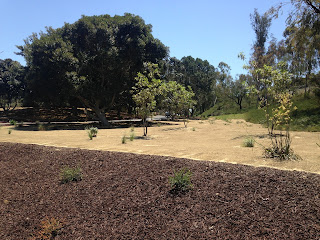 In 3 weeks, United GLI has finished holes 12, 13, 14, and 15 and the 16th hole is being planted today. All turf to be removed is stripped off number 17 which will be irrigated with drip emitters next week. The tee complexes on #'s 11, and 18 are also ready for new plantings and then it's on to holes 10 and 11.
In 3 weeks, United GLI has finished holes 12, 13, 14, and 15 and the 16th hole is being planted today. All turf to be removed is stripped off number 17 which will be irrigated with drip emitters next week. The tee complexes on #'s 11, and 18 are also ready for new plantings and then it's on to holes 10 and 11.If you haven't been to the club recently, there are changes to be seen from the moment you pull up the driveway. For 3 years, I've wanted to remove the grass that struggled under the ficus trees and dress up our entry with drought tolerant plants that look good year round. I'm pretty happy with the new look as are many of the club's visitors.


The driving range is missing a few plants that divided the pavement from the back tee. We are transplanting the palms and ornamental garlic to make room for more tee space. The back tee of the range will be renovated in-house over the next month and this is step number one. We should gain about 5 days worth of practice, all of which will be on level bermudagrass.

The fairway on #13 has finally been sprayed out with Monument herbicide which eliminates cool season grass, leaving only bermuda behind. This is the last fairway, besides some of the par 3's. I'm pretty happy with the amount of bermuda that we have to work with. Most areas will fill in the small voids and we will sod any large sections. As intended, we will have 100% bermuda fairways by the end of this summer, 3 years after beginning this campaign and 5 years post-overseeding.
New turf on a reshaped, combo tee for #'s 11 and 18 looks a little brown, but don't worry. Bermuda sod will often turn brown if it becomes stressed out as a defense mechanism to limit carbohydrate reserves until there are better conditions. As you can see, there are many new white roots already 3 inches into the soil. This sod will be solid green in no time.

